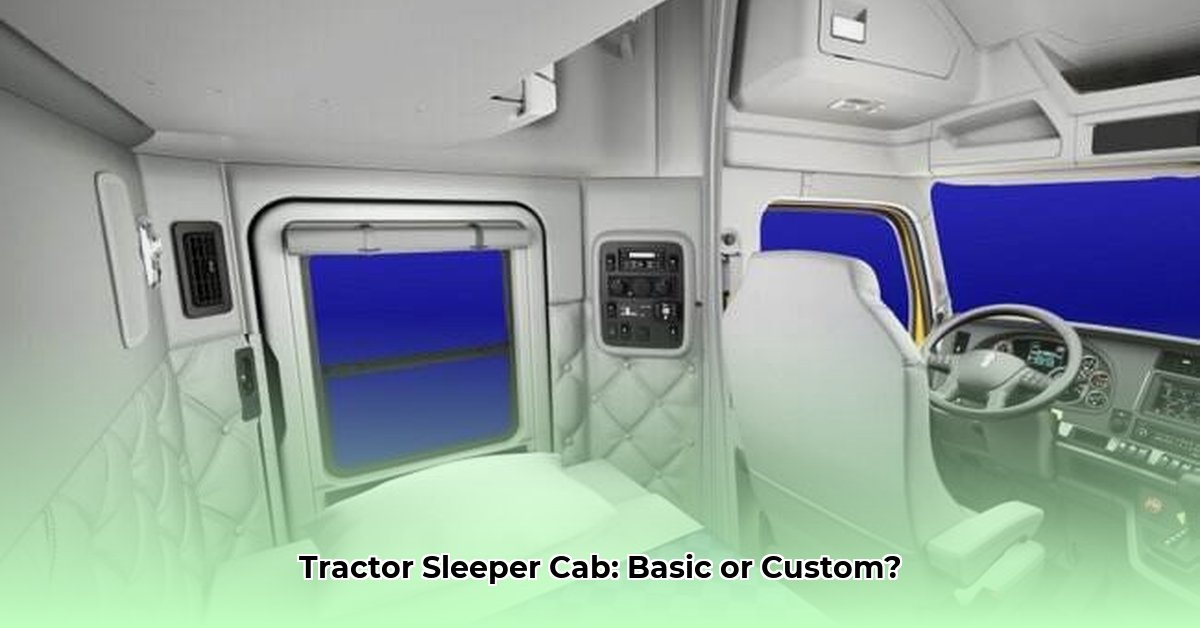
Choosing the right sleeper cab for your semi-truck is a crucial decision impacting driver comfort, operational efficiency, and overall profitability. This comprehensive guide compares basic and custom sleeper cabs across key dimensions, helping you determine the optimal choice for your needs. For more detailed specifications, check out this tractor cab resource.
Cost: Initial Investment vs. Long-Term Returns
The most significant difference between basic and custom sleeper cabs lies in cost. Basic cabs offer a lower upfront investment, representing a more budget-friendly option for fleet owners or drivers focused on essential functionality. However, custom cabs represent a substantially higher initial investment, potentially doubling or tripling the cost. This increased expenditure allows for personalized features and enhanced comfort, potentially leading to long-term cost savings through improved driver well-being and reduced downtime. Quantifying this precise return on investment (ROI) requires further research, however. The complexity of factors such as driver utilization, operational efficiency, and maintenance frequency necessitates further study.
Features & Amenities: Comfort, Convenience, and Technology
Basic sleeper cabs provide essential amenities: a bed, minimal storage, and basic climate control. Custom cabs, however, offer a wide array of customizable options for a significantly enhanced living environment.
| Feature | Basic Tractor Sleeper Cab | Custom Tractor Sleeper Cab |
|---|---|---|
| Bed Size | Standard, often smaller (around 6 feet) | Customizable, often larger (7-8 feet or more) |
| Storage Space | Limited to a few small compartments | Extensive, with overhead, under-bed, and side-wall storage |
| Climate Control | Basic AC and heating | Advanced climate control, potentially zoned for precision |
| Entertainment System | Minimal or none | Full entertainment system (TV, sound system, satellite radio) |
| Bathroom | None | Integrated bathroom (impacts weight and fuel efficiency) |
| Other Amenities | Possibly a small fridge, limited lighting | Customized options (microwave, coffee maker, etc.) |
Operational Impacts: Fuel Efficiency, Aerodynamics, and Weight
Larger, custom cabs generally weigh more, resulting in decreased fuel efficiency and potentially impacting payload capacity. Increased aerodynamic drag from a larger cab profile can further reduce fuel economy. However, the enhanced driver comfort and reduced fatigue associated with custom cabs might offset these fuel costs through improved productivity and reduced downtime. The optimal balance between comfort and fuel efficiency requires careful consideration based on individual operational needs.
Driver Perspective: Real-World Experiences
"A basic cab gets the job done," states John Miller, a company driver with 15 years of experience. "Comfort is important, but I prioritize reliability and ease of maintenance." In contrast, Sarah Chen, an owner-operator, emphasizes the benefits of her custom cab: "My cab is my home. The investment in comfort and amenities improves my well-being and overall operational efficiency." These contrasting perspectives highlight the importance of aligning sleeper cab choice with individual needs and priorities. The difference between a comfortable, customized space and a purely functional one significantly affects a driver’s quality of life and work productivity.
Maintenance & Upkeep: Long-Term Cost Considerations
Basic sleeper cabs typically require less maintenance and present lower repair costs. Custom cabs, with their complex systems and added features, may demand more frequent inspections and potentially higher repair costs. This increased complexity must be carefully weighed against the enhanced comfort. Preventative maintenance is crucial for all cabs, but especially critical for custom configurations to mitigate unexpected breakdowns and associated downtime.
Regulatory Compliance: Current and Future Standards
Safety and environmental regulations shape sleeper cab design. Safety standards influence cab dimensions, while emissions regulations drive advancements in fuel efficiency and reduced environmental impact. Staying informed about current and future regulations is crucial for both manufacturers and users. Upcoming regulations are likely to further emphasize fuel efficiency and reduce environmental footprint, prompting innovative designs and material choices.
Conclusion: Choosing the Right Sleeper Cab
The choice between basic and custom sleeper cabs depends on individual priorities and budgets. Basic cabs are cost-effective but lack the comfort and convenience of custom designs. Custom solutions provide a significantly enhanced driving experience but come with a higher initial investment and ongoing maintenance costs. Careful consideration of long-term costs, fuel efficiency, driver well-being, and regulatory compliance is essential for making an informed decision. For fleet managers, a standardized basic cab may be the cost-effective solution, while owner-operators may find the increased comfort and productivity of a custom cab a worthwhile investment.